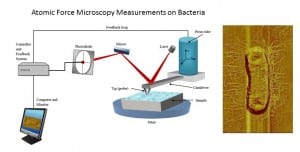Study published on large bacterial protein responsible for adhesion
The Camesano lab recently published a study in the Journal of Bionanoscience on the role of a large adhesion proteins, LapA and LapG, in controlling the behavior of Pseudomonas fluorescens. This study was led by WPI alum Mary Schwartz, who graduated with a BS in Chemical Engineering in 2014. The study was done in collaboration with WPI faculty and graduate students from the Department of Physics, led by Professor Nancy Burnham, as well as Professor George O’Toole from the Dartmouth Geisel School of Medicine. The team used atomic force microscopy to measure the nanoscale interaction forces that are associated with bacterial surfaces, and applied modeling to help explain how certain proteins affected the adhesion. This work has implications for the study of microbial biofilms,which are communities of bacteria that colonize surfaces, and can lead to serious contamination or infection issues.
The lead author, Ms. Schwartz, is currently working in the biotech industry in Cambride, MA, and intends to begin graduate studies soon while continuing her industrial career.

